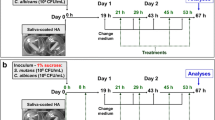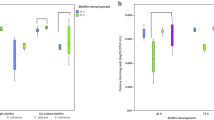Abstract
The effect of two dietary sugars, glucose and galactose, on biofilm formation of the oral fungal pathogen Candida on denture acrylic strips coated with saliva and serum pellicles was examined in vitro using Candida albicans (3 isolates), C. glabrata (2 isolates) and C. tropicalis (2 isolates). The degree of biofilm activity was affected by both the dietary sugar and the nature of the pellicle (ANOVA, p < 0.01). With most isolates the glucose grown yeasts demonstrated significantly more bioflim activity than the galactose grown fungi, in the presence of pellicles (ANOVA, p < 0.01 or P < 0.01). In contrast, one isolate of galactose-grown yeast elicited significantly higher biofilm activity than glucose-grown yeasts on the control strips (ANOVA, p < 0.01). Taken together, these results imply that a saliva or a serum pellicle, and the carbon source in the environment, act a complex manner modulating Candida bioflim formation.
Similar content being viewed by others
References
Bouali, A, Robert R, Tronchin G, Senet J-M. Binding human fibrinogen to Candida Albicans in vitro: A preliminary study. Journal of Medical and Veterinary Mycology 1986; 24: 345–348.
Bouchara J-P, Tronchin G, Annaix V, Robert R, Sennet J-M. Laminin receptors on Candida albicans germ tubes. Infection and Immunity 1990; 58: 48–54.
Budtz-Jorgensen E. The significance of Candida albicans in denture stomatitis. Scandinavian Journal of Dental Research 1974; 82: 151–190.
Budtz-Jorgensen E. Candida-associated denture stomatitis and angular cheilitis. In: Samaranayake LP, MacFarlane TW. edi. Oral candidosis. London: Wright, 1990; 156–183.
Bull FG, Turner NR. A serum mannan-binding protein and candidiasis. Sabouraudia (Journal of Medical and Veterinary Mycology) 1984; 22: 347–350.
Cannon RD, and AK, Jenkinson HF. Adherence of Candida albicans to human salivary components adsorbed to hydroxylapatite. Microbiology (UK), 1995; 141: 213–219.
Critchley IA, Douglas U. Differential adhesion of pathogenic Candida species to epithelial cells and inert surfaces. FEMS Microbiological Letter 1985; 28: 199–203.
Davenport JC. The oral distribution of Candida in denture stomatitis. British Dental Journal 1970; 129: 151–156.
Edgerton M, Scannapieco FA, Reddy MS, Levine MJ. Human submandibular-sublingual saliva promotes adhesion of Candida albicans to polymethylmethacrylate. Infection and Immunity 1993; 61: 2644–2652.
Hawser SP, Douglas U. Biofilm formation by Candida species on the surface of catheter materials in vitro. Infection and Immunity 1994; 62: 915–921.
McCourtie J, Douglas U. Relationship between cell surface composition of Candida albicans and adherence to acrylic after growth on different carbon sources. Infection and Immunity 1981; 32: 1234–1241.
McCourtie J, Douglas U. Relationship between cell surface composition, adherence, and virulence of Candida albicans. Infection and Immunity 1984; 45: 6–12.
McCourtie J, MacFarlane TW, Samaranayake LP. Effect of saliva and serum on the adherence of Candida species to chiorhexidine-treated denture acrylic. Journal of Medical Microbiology 1986; 21: 209–213.
Nikawa H, Hamada T. Binding of salivary or serum proteins to Candida albicans in vitro. Archives of Oral Biology 1990; 35: 571–573.
Nikawa H, Sadamori S, Hamada T, Okuda K. Factors involved in the adherence of Candida albicans and Candida tropicalis to protein-adsorbed surfaces. Mycopathologia 1992; 118: 139–145.
Nikawa H, Hayashi S, Nikawa Y, Hamada T, Samaranayake LP. Interactions between denture lining material, protein pellicles and Candida albicans. Archives of Oral Biology 1993; 38: 631–634.
Nikawa H, Nishimura H, Yamamoto T, Hamada T, Samaranayake LP. The role of salivary or serum pellicle in the colonization process of Candida albicans on denture acrylic in vitro. Microbial Ecology in Health and Disease 1996; 9: 35–48.
Page S, Odds FC. Binding of plasma proteins to Candida species in vitro. Journal of General Microbiology 1988; 134: 2693–2702.
Rotrosen D, Calderone RA, Edwards Jr JE. Adherence of Candida species to host tissues and plastic surfaces. Reviews in Infectious Disease 1986; 8: 73–85.
Samaranayake LP, MacFarlane TW. An in vitro study of the adherence of Candida albicans to acrylic surfaces. Arciuves of Oral Biology 1980; 25: 603–609.
Samaranayake LP, McCourtie J, MacFarlane TW. Factors affecting the invitro adherence of Candida albicans to acrylic surfaces. Archives of Oral Biology 1980; 25: 603–609.
Samaranayake LP, Geddes DAM, Weetmen DA, MacFarlane TW. Growth and acid production of Candida albicans in carbohydrate supplemented media Microbios 1983; 37: 105–115.
Samaranayake LP, Hughes A, MacFarlane TW. The proteolytic potential of Candida albicans in human saliva supplemented with glucose. Journal of Medical Microbiology 1984; 17: 13–22.
Saniaranayake LP, Raeside J, MacFarlane TW. Factors affecting the phospholipase activity of Candida species in vitro. Sabouraudia (Journal of Medical and Veterinary Mycology) 1984; 22: 201–207.
Samaranayake LP, MacFarlane TW. Hypothesis: on the role of dietary carbohydrates in the pathogenesis of oral candidosis. FEMS Microbiology Letters 1985; 527: 1–5.
Silverman Jr S, Migliorati CA, Epstein JB, Samaranayake LP. Laboratory diagnosis of oral candidosis. In: Samaranayake LP, MacFarlane TW. eds. Oral Candidosis. London: Wright 1990; 213–237.
Tronchin G, Robert R, Bouali A, Senet JM. Immunocytochemical localization of in vitro binding of human fibrinogen to Candida albicans germ tube and mycelium. Annual Inst Pasteur/Microbiology 1987; 138: 177–187.
Author information
Authors and Affiliations
Rights and permissions
About this article
Cite this article
Nikawa, H., Nishimura, H., Hamada, T. et al. Effects of dietary sugars and saliva and serum on Candida bioflim formation on acrylic surfaces. Mycopathologia 139, 87–91 (1997). https://doi.org/10.1023/A:1006851418963
Issue Date:
DOI: https://doi.org/10.1023/A:1006851418963




